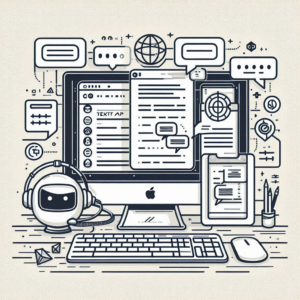Language Translation Desktop App with the ChatGPT API and Microsoft Word

Introduction
In the era of globalization, the ability to communicate across language barriers is crucial for individuals and businesses, particularly in the context of cloud migration. The rapid advancements in Natural Language Processing (NLP) technologies have made language translation more accessible and accurate than ever. This blog post will guide you through the process of building a language translation desktop application using the OpenAI ChatGPT API and Microsoft Word, leveraging Python and its libraries.
Technical Requirements for Application Migration
Before diving into the development process, ensure you have the following prerequisites for a successful application migration:
Python 3.7 or later
The programming language we will use for this project.
Code Editor
Visual Studio Code (VSCode) is recommended for its robust features.
Python Virtual Environment
To manage dependencies effectively.
OpenAI API Key
Required to access the ChatGPT API.
Microsoft Word
Installed on your machine to work with .docx files.
Setting Up Your Environment for Microsoft Azure Cloud Migration
Create a Project Directory: Start by creating a new directory called `TranslationApp` and open it in VSCode.
Set Up a Virtual Environment:
“`bash
python -m venv venv
source venv/bin/activate # On Windows use `venv\Scripts\activate`
“`
Install Required Libraries:
“`bash
pip install openai python-docx tkinter
“`
Integrating the ChatGPT API with Google Cloud Platform
The first step in our application is to set up integration with the ChatGPT API. The `python-docx` library will help us read and write Microsoft Word (.docx) files.
Creating the Configuration File
Create a file named `config.py` in your project directory to store your OpenAI API key securely:
“`python
# config.py
API_KEY = “”
“`
Reading Text from Word Documents
To extract text from a Word document, we will use the `docx` library. Below is a function that reads the contents of a .docx file:
“`python
import docx
def read_word_file(file_location):
doc = docx.Document(file_location)
text = “”
for para in doc.paragraphs:
text += para.text + “\n”
return text
“`
Building the User Interface with Tkinter
Tkinter is a built-in Python library that allows us to create graphical user interfaces (GUIs). We will create a simple interface that includes a dropdown menu for language selection and a button to browse for Word files.
Creating the Main Window
Here’s how to set up the main window of our application:
“`python
import tkinter as tk
from tkinter import filedialog
import openai
import config
# Initialize the main window
root = tk.Tk()
root.title(“Text Translator”)
root.configure(bg=”white”)
# Header
header_font = (“Open Sans”, 16, “bold”)
header = tk.Label(root, text=”Text Translator”, bg=”white”, font=header_font)
header.grid(row=0, column=0, columnspan=2, pady=20)
“`
Adding Functionalities to the GUI
Language Selection
We will create a dropdown menu for users to select the target language for translation. Here’s how to implement it:
“`python
# Language options
languages = [“English”, “Spanish”, “French”, “German”, “Chinese”]
language_var = tk.StringVar(root)
language_var.set(languages[0]) # Default value
language_menu = tk.OptionMenu(root, language_var, *languages)
language_menu.grid(row=1, column=0, padx=10, pady=10)
“`
Browse Button
Next, we will add a button that allows users to browse and select a Word file:
“`python
def browse_file():
file_location = filedialog.askopenfilename(
initialdir=”/”,
title=”Select file”,
filetypes=((“Word files”, “*.docx”), (“all files”, “*.*”))
)
if file_location:
target_language = language_var.get()
translated_text = translate_text(file_location, target_language)
text_field.delete(“1.0”, tk.END)
text_field.insert(tk.END, translated_text)
browse_button = tk.Button(root, text=”Browse”, command=browse_file)
browse_button.grid(row=1, column=1, padx=10, pady=10)
“`
Translating Text with the ChatGPT API
The core functionality of our application revolves around the translation process. We will define a function that interacts with the ChatGPT API to perform the translation.
Translation Function
Here’s how to implement the `translate_text` function:
“`python
def translate_text(file_location, target_language):
text = read_word_file(file_location)
model_engine = “gpt-3.5-turbo”
response = openai.ChatCompletion.create(
model=model_engine,
messages=[
{“role”: “user”, “content”: f”Translate the following text to {target_language}: {text}”}
],
api_key=config.API_KEY
)
translated_text = response.choices[0].message.content
return translated_text
“`
Displaying Translated Text
We will create a text area in the GUI to allow users to view the translated text:
“`python
text_field = tk.Text(root, height=15, width=50)
text_field.grid(row=2, column=0, columnspan=2, padx=10, pady=10)
“`
Running the Application
Finally, we will run the Tkinter main loop to display the application:
“`python
root.mainloop()
“`
Summary of Cloud Migration and Application Migration Process
In this blog post, we created a simple yet effective language translation desktop application using the ChatGPT API and Microsoft Word. We covered essential steps such as:
1. Setting up the development environment suitable for Microsoft Azure cloud migration.
2. Integrating the ChatGPT API with Microsoft Word using the `python-docx` library.
3. Building a user-friendly interface with Tkinter to enhance user experience.
4. Implementing the translation functionality to cater to diverse language needs.
By implementing this application, you lay a strong foundation for future projects, allowing you to expand its functionality further—such as saving translated text back to Word formats, supporting more languages, or enhancing the user interface.
If you need software services, visit Cloudastra Technologies. We specialize in helping businesses with their software needs. Contact us for more inquiries!
Do you like to read more educational content? Read our blogs at Cloudastra Technologies or contact us for business enquiry at Cloudastra Contact Us.